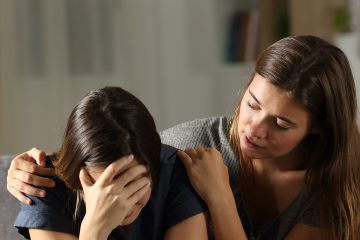Please take a moment to read this fact sheet posted by Christian Life Resources regarding teen abortion risks.
“Parents are faced with a shell of a person and have no idea where they lost their child.” – Terri, who had a secret abortion as a teen
Teens are 10 times more likely to try to kill themselves
Teenage girls are 10 times more likely to attempt suicide if they have had an abortion in the last six months than are teens who have not had an abortion (1).
Teens who abort are 2 to 4 times more likely to commit suicide than adults who abort (2), and a history of abortion is likely to be associated with adolescent suicidal thinking (3).
Overall suicide rates are 7 times higher among women who abort (4).
Teens who abort are more likely to develop psychological problems (5), and are nearly three times more likely to be admitted to mental health hospitals than teens in general (6).
About 40% of teen abortions take place with no parental involvement (7), leaving parents in the dark about subsequent emotional or physical problems.
Teens risk further injury or death because they are unlikely to inform parents of any physical complications. Some examples of teens who died from complications or suicide after they had abortions without telling their parents (8).
- Holly Patterson, California, died at age 18
- Dawn Ravanell, New York, died at age 13
- Erica Richardson, Maryland, died at age 16
- Tamia Russell, Detroit, died at age 15
- Sandra Kaiser, St. Louis, died at age 14 of suicide – Sandra died 3 weeks after her half-sister took her for an abortion without telling Sandra’s mother, who could have warned doctors about Sandra’s history of psychological problems that put her at risk for more problems after abortion (9).
- 65% higher risk of clinical depression among women who abort (10).
- 65% experienced multiple symptoms of post-traumatic stress disorder (PTSD) among women who abort (11).
- 64% of women surveyed after abortion reported feeling pressured by others to abort (12).
- High risk of pain, grief, life-threatening injury
Acute pain
Teens report more severe pain during the abortion procedure vs. adult women. One study of pain during 1st-trimester abortions found severe acute pain comparable to childbirth or cancer. Pain scores were significantly higher for teens (13).
Lacerations up to twice as likely
Teens are up to twice as likely to experience dangerous cervical lacerations during abortion compared to older women, probably because they have smaller cervixes that are more difficult to dilate or grasp with instruments (14).
Serious infection, infertility and other complications
Teens are at higher risk for post-abortion infections, such as pelvic inflammatory disease (PID) and endometritis because their bodies are more susceptible to infection and are less likely than older women to follow instructions for medical care (15). These infections increase their risk of infertility, hysterectomy, ectopic pregnancy and other serious complications (16).
Breast cancer risk 30-50% higher
An early full-term birth reduces breast cancer risk by as much as 1/3, while abortion of a first pregnancy carries a 30- to 50% increased risk of breast cancer (17). More than 90% of those who abort at 17 or younger have not had a previous full-term pregnancy, compared to 78% of patients age 18-19 and 49% of abortion patients overall (18).
Teens are more likely to abort because of pressure from their parents or partner (19).
Teens are more likely to report being misinformed in pre-abortion counseling (20).
Teens are more likely to have riskier late-term abortions
According to the CDC, approximately 30% of abortions among teens take place at 13 weeks gestation or greater, compared to only 12% among women in general (21). Late-term abortions are associated with:
More severe psychological complications
This is often because the woman wants to continue the pregnancy but ends up aborting because of pressure from others or her circumstances (22). Women who have 2nd-trimester abortions are more likely to express ambivalence, regret, moral or religious objections, and to have a more favorable attitude toward the unborn child than women having 1st-trimester abortions (23).
Higher risk of serious physical complications
Teens who abort in the 2nd and 3rd trimesters face a greater risk of physical complications, including endometritis, intrauterine adhesions, PID, subsequent miscarriages, ectopic pregnancies, ruptured uterus and death (24).
Trouble with later pregnancies for mother and baby
D&E abortions, frequently used in the second trimester, are associated with low birth weight in later pregnancies, which can lead to health and developmental problems for the baby, including cerebral palsy (25).
Grief, trauma and self-destructive outcomes
- Teens who abort are twice as likely as their peers to abuse alcohol, marijuana, or cocaine (26).
- Teens have greater difficulty coping after abortion (27), leading to problems such as suicide, psychological problems, substance abuse and difficulty in relationships.
- Negative effects on relationships and parenting. Teens who report “being particularly fond of children” do not do as well psychologically after an abortion (28). Teenagers who have abortions often have problems regarding sexuality and parenting later in life (29).
- A lonely, traumatic experience. The abortion procedure itself is considered by many teenagers to be stressful and associated with feelings of guilt, depression and a sense of isolation (30).
- A nightmare that doesn’t end. Teens are more likely to report severe nightmares and to score higher on scales measuring antisocial traits, paranoia, drug abuse and psychotic delusions than are older abortion patients (31).
- Four times higher risk of repeat abortion. Teens who abort are likely to become pregnant again within the next few years (32). Among pregnant teens, those who had had an abortion were at least 4 times more likely to abort (33).
Citations
1. B. Garfinkel, et al., “Stress, Depression and Suicide: A Study of Adolescents in Minnesota,” Responding to High-Risk Youth (University of Minnesota: Minnesota Extension Service, 1986)
2. M. Gissler, et. al., “Suicides After Pregnancy in Finland: 1987-94: register linkage study,” British Medical Journal, 313: 1431-1434, 1996; and N. Campbell, et. al., “Abortion in Adolescence,” Adolescence, 23:813-823, 1988.
3. B. Garfinkel, et al., op. cit.
4. M. Gissler, et. al., op. cit.
5. W. Franz & D. Reardon, “Differential Impact of Abortion on adolescents and adults,” Adolescence, 27 (105), 172, 1992.
6. R. Somers, “Risk of Admission to Psychiatric Institutions Among Danish Women Who Experienced Induced Abortion: An Analysis Based on National Report Linkage” (Ph.D. Dissertation, Los Angeles: University of California, 1979, Dissertation Abstracts International, Public Health 2621-B, Order No. 7926066)
7. “Teenage Pregnancy: Overall Trends and State-by-State Information,” Report by the Alan Guttmacher Institute, Washington, DC, www.agi.org.
8. S. Ertelt, “Woman Dies Following Use of RU-486 Abortion Drug,” posted at www.lifenews.com, Sept. 19, 2003; K. Sherlock, Victims of Choice (Akron: Brennyman Books, 1996) 31-32, 40-41; and P. Nowak, “Family of Detroit Girl Who Died From Abortion Speaks Out,” posted at www.lifenews.com, April 9, 2004.
9. R. Kerrison, “Horror Tale of Abortion,” New York Post, Jan. 7, 1991.
10. JR Cougle, DC Reardon & PK Coleman, “Depression Associated With Abortion and Childbirth: A Long-Term Analysis of the NLSY Cohort,” Medical Science Monitor 9(4): CR105-112, 2003.
11. VM Rue et al., “Induced abortion and traumatic stress: A preliminary comparison of American and Russian women,” Medical Science Monitor 10(10): SR5-16, 2004.
12. Ibid.
13. 23. E. Belanger, et al., “Pain of First Trimester Abortion: A Study of Psychosocial and Medical Predictors,” Pain, 36:339; and G.M. Smith, et al., “Pain of first-trimester abortion: Its quantification and relationships with other variables,” American Journal Obstetrics & Gynecology,133:489, 1979.
14. R.T. Burkman, et. al., “Morbidity Risk Among Young Adolescents Undergoing Elective Abortion,” Contraception, 30(2):99, 1984; and K.F. Schulz, et al., “Measures to Prevent Cervical Injury During Suction Curettage Abortion,” The Lancet, 1182-1184, May 28, 1993.
15. R.T. Burkman, et. al., “Culture and treatment results in endometritis following elective abortion,” American J. Obstet. & Gynecol., 128:556, 1997; and D. Avonts and P. Piot, “Genital infections in women undergoing induced abortion,” European J. Obstet. & Gynecol. & Reproductive Biology, 20:53, 1985; and W. Cates, Jr., “Teenagers and Sexual Risk-Taking: The Best of Times and the Worst of Times,” Journal of Adolescent Health, 12:84, 1991.
16. “Teenage Pregnancy: Overall Trends and State-by-State Information,” Report by the Alan Guttmacher Institute, Washington, DC, www.agi.org.
17. J. Brind, et. al., “Induced abortion as an independent risk factor for breast cancer: a comprehensive review and analysis,” Epidemiology & Community Health, 50:481, 1996.
18. K.D. Kochanck, “Induced Terminations of Pregnancy, Reporting States 1988,” Monthly Vital Statistics Report, 39(12): Suppl. 1-32, April 30, 1991.
19. P. Barglow and S. Weinstein, “Therapeutic Abortion During Adolescence: Psychiatric Observations,” Journal of Youth and Adolescence, 2(4):33, 1973.
20. W. Franz & D. Reardon, “Differential Impact of Abortion on adolescents and adults,” Adolescence, 27 (105), 172, 1992.
21. T. Strahan, “Differential Adverse Impact on Teenagers Who Undergo Induced Abortion,” Association for Interdisciplinary Research Bulletin, 15(1):3, March/April 2000.
22. D. Reardon, Making Abortion Rare (Springfield, IL: Acorn Books, 1996) 162.
23. T. Strahan, “Psycho-Social Aspects of Late-Term Abortions,” Assoc. For Interdisciplinary Research Bulletin, 14(4):1, 2000.
24. R.T. Burkman, et. al., “Culture and treatment results in endometritis following elective abortion,” American J. Obstet. & Gynecol., 128:556, 1997; and S. Lurie and Z. Shoham, “Induced Midtrimester Abortion and Future Fertility: Where Are We Today?” International J. of Fertility, 40(6):311, 1995.
25. H.K. Atrash and C.J. Hogue, “The effect of pregnancy termination on future reproduction,” Baillieres Clinic Obstet. & Gynecol., 4(2):391, 1990; and B. Rooney, “Is Cerebral Palsy Ever a Choice?” The Post-Abortion Review, 8(4):4-5, Oct.-Dec. 2000.
26. H. Amaro, et al., “Drug use among adolescent mothers: profile of risk,” Pediatrics, 84, 1989, 144-150.
27. Horowitz, “Adolescent Mourning Reactions to Infant and Fetal Loss,” Soc. Casework, 59:551, 1978.
28. E. M. Smith, “A follow-up study of women who request abortion,” American Journal of Orthopsychiatry, 1973, 43: 574-585.
29. G. Zakus, G. & Wilday, “Adolescent Abortion Option.” Social Work in Health Care, 12, 1987, 77-91.
30. F. Biro, et al., “Acute and Long-Term Consequences of Adolescents Who Choose Abortions,” Pediatric Annals, 15(10):667-672, 1986.
31. N. Campbell, et. al., “Abortion in Adolescence,” Adolescence, 23:813-823, 1988.
32. S.R. Wheeler, “Adolescent Pregnancy Loss,” in J.R. Woods, Jr. and J.L. Woods (eds.), Loss During Pregnancy or the Newborn Period (1997); and H. Cvejic et. al., “Follow-up of 50 adolescent girls 2 years after abortion,” Canadian Medical Assoc. Journal, 116:44, 1997.
33. T. Joyce, “The Social and Economic Correlates of Pregnancy Resolution Among Adolescents in New York by Race and Ethnicity: A Mulitvariate Analysis,” American J. of Public Health, 78(6):626, 1988.



0 Comments